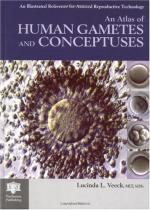|
This section contains 182 words (approx. 1 page at 300 words per page) |
A gamete is a sexual reproductive cell such as a sperm or an egg that must fuse with another gamete to produce a zygote, and eventually, a new organism. Gametes are typically haploid (1N), containing only half the number of the chromosomes needed to form a new diploid (2N) organism. During fertilization, two unlike gametes, each containing a single set of chromosomes, fuse to produce a diploid cell, or zygote, containing paired chromosomes. The zygote develops into a new diploid organism. Specialized cells of the mature organism undergo meiosis to form haploid gametes that begin the process of reproduction again. Although fusing gametes normally differ from each other genetically, they may be identical in form (isogamy) or they may differ in size and shape (heterogamy). An extreme case of heterogamy, where one gamete is large and nonmotile (the egg), and the other is small and motile (the sperm) is called oogamy. Oogamy is the type of gamete formation typical of animals, plants, and some forms of fungi and algae. Isogamy and heterogamy are found in many fungi, algae, and protista.
|
This section contains 182 words (approx. 1 page at 300 words per page) |


